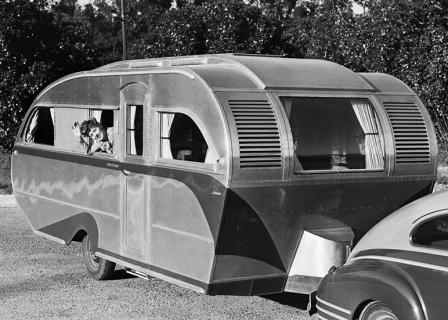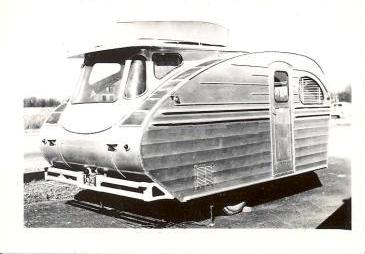The Falcon was the larger of the two models at 20 feet overall and with a body length of 18 feet. The trailer body was 94 inches wide, counting the projection of the rub rails, and the trailerís height was 8 feet 8 inches. The Falcon had a clerestory style roof, which allowed it to have a higher interior roof height than other trailers of comparable length and general styling. This added height accommodated taller individuals and improved airflow through the trailer, while also contributing to a very roomy feel. According to the companyís early advertisements, in 1946, the Aero Flite Falcon weighed only 1860 pounds. A specification sheet found in a 1948 Falcon showed the weight listed at 2400 pounds. The relative light weight was achieved through careful attention to material selection as well as construction methods and overall design.
Aero Flite Trailers
"America's Smartest Trailers"
Trailer Information
Models
When the company operated under the Aero Services, Incorporated name, two trailers were built as prototypes, or "pilots." All of the other trailers were built when the company operated under the Aero Lines, Incorporated name. Aero Lines built two models of trailers: the Eagle and the Falcon.
Photo credit: University of Nevada at Reno
The only known information about the Eagle is one photograph that appears to have been taken in 1948. It is unknown if the Eagle ever made it to production and, if so, how many trailers were produced. The Eagle was smaller than the Falcon but shared some of the same styling features, some of which were uniquely Aero Flite. The Eagle resembles the Falcon in its overall appearance and in the use of design elements common to the Falcon, such as a streamlined propane bottle cover, air louvers in the front panel and door, and the shape of the windows and wheel openings. It is estimated the length of the Eagleís length was approximately 13 feet.


The photograph to the left depicts one of the two pilot trailers built by Aero Services. The photograph immediately above it depicts a 1948 Falcon. The trailers reflect many of the production changes that occurred between the pilots and the late production trailers. Some of the subtle changes included elimination of the arched entry door, which only appeared on the prototypes. The removable panel in the door of the prototype had been replaced by a functional vent on the later trailers. The porthole window in the door appeared on 1948 models. The streamlined tank cover on the prototype was hinged, whereas on later trailers an access hole was provided in the top of the cover. Small storage compartments at the bottom of the front panel on the prototype were discontinued early in the production run. The prototype had flat sides and distinctive painted stripes, compared to the 1948, which had sides that were adorned with horizontal runs and were absent painted stripes.

The trailer to the right is not an Aero Flite, nor is it a product of Aero Lines or Aero Services. The trailer is a Great Western and was designed by Frederick C. Hoffman, designer of Aero Flite. The photo is included here to show the design similarities between the Great Western and Aero Flite, and as another example of Hoffman's design excellence.
IMPORTANT NOTE: All content on this website is owned by Kevin Reabe and is copyright protected.
Company History
Trailer Information
Other Information



